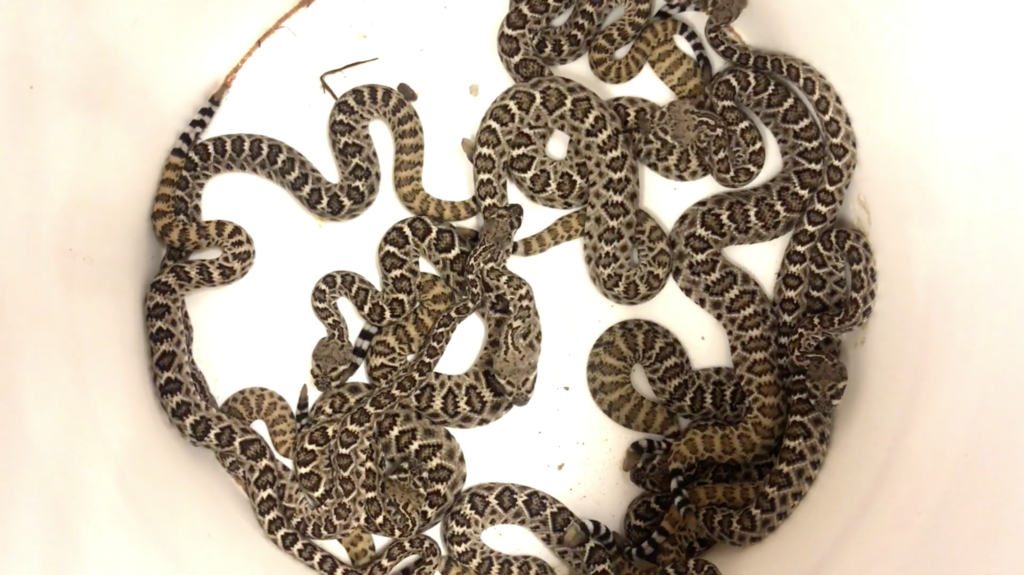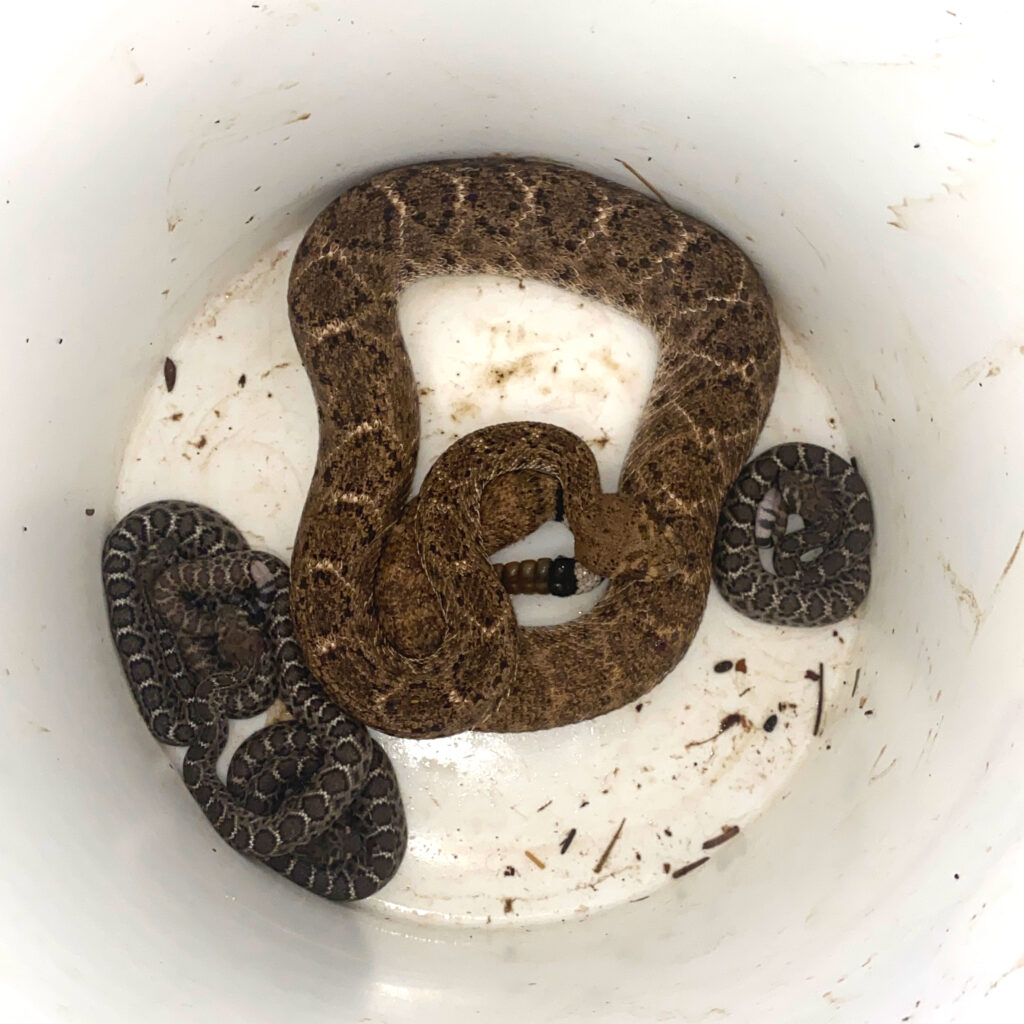
Recent changes in ambient humidity has triggered the start of baby rattlesnake season! Across the state, mama rattlesnakes are tucked away in shaded, damp areas to give birth to babies (they do not lay eggs as is commonly believed). After spending some quality time with mom, the babies are all set to head out into the big world to figure out how to be a rattlesnake.
The behavior that often brings rattlesnakes into an area is a little different for these new little guys, and as a homeowner you should know what you can do to keep baby rattlesnakes away.
This means two big things for homeowners who wish to keep baby rattlesnakes away. First, baby rattlesnakes can show up at any place, any time, without a reason. Second, it becomes even more important to reduce access and opportunities for rattlesnakes in general.
First, let’s learn a bit about baby rattlesnakes. Here’s a Q&A session we did last year that should cover the basics. This post is all about what homeowners can do to prevent baby rattlesnakes from showing up on the patio, however, so we’ll rely on our previous work to talk about how cute they are:
Baby rattlesnakes are wanderers
We often discuss the behavior of rattlesnakes that brings them into yards. Things like moisture-rich pool equipment areas or an unsealed garage (aka, cool cave) are often taken advantage of by rattlesnakes for the opportunities they provide.
Baby rattlesnakes, on the other hand, have no such experience. After they leave their mother (a week or so after being born), their instinct is to wander wide and far searching for what will eventually be its lifelong home range.
As they kick the tires of life, they’re making frequent movements. They will need to eat, find reliable places to get water, and map a variety of spots to stay during different times of year. As babies, however, they have no idea where these things are, so they have to find them.
That means that you can easily find baby rattlesnakes in places where there are no real reasons for them to be there. We often find them in busy parking lots, sidewalks, and shopping centers. At homes, they can be anywhere, often ducking into temporary cover situations regardless of if they can truly survive there or not.
This can also present some challenges with the typical prevention methods because baby rattlesnakes are small. How small? Our testing has shown that any space as small as a third of an inch in diameter can allow entry of baby rattlesnakes:
What you can do about it to keep baby rattlesnakes away:
- Keep cover situation, even stuff you plan on throwing away the next day, up off the ground and to a minimum. This includes pool toys, shoes,temporary construction debris, and that stack of Amazon boxes.
- Create a barrier to keep wandering baby rattlesnakes out of the yard entirely.
- Double up on landscaping efforts to make sure as few shaded and cool areas as possible are available.
- If you have rattlesnake fencing installed or are thinking about getting it, make sure that it is done in such a way that it keeps baby rattlesnakes out as well.
Baby rattlesnakes are making a map
As these little newborn rattlesnakes wander around the world searching for all the stuff that makes a rattlesnake happy, it’s not without purpose. Each time they get it right, whether it succeeding in finding food, water, or a spot to hide away, they’re taking note.
Just like you do when you’re on vacation and remember good and convenient spots to get food, coffee, and wifi, baby rattlesnakes are in the map making business. This is why it’s more important now than ever to take action to make your yard less attractive to rattlesnakes. If you’re providing a resource, you may have a repeat guest for life.

What you can do to keep baby rattlesnakes from adding your yard to favorites:
- Remove as many attracting features as possible. Start with the easy stuff you can do in just a few hours, then move on to larger and more complicated items.
- Cut bushes back from walls and use a garden hose to flood any rodent burrows you find, especially near the house.
- Contact a garage door company and make sure the seal at the base of your garage door is sealed up.
- Have a professional rattlesnake prevention specialist come inspect the property to find signs of baby rattlesnakes and identify attracting features.
- Avoid using snake repellents (they don’t work and give false peace of mind)
Above all else, be mindful and keep your eyes open
The random nature of encounters when it comes to baby rattlesnakes mean that every homeowner, hiker, or visitor to places where rattlesnakes can be found should be paying attention.
Baby rattlesnakes are born with a single rattle segment. That’s cute, but it won’t make a sound until its second shed skin, several weeks after it is born. It may try and rattle anyway, but you won’t hear it. That means the courtesy buzz that tells you when you’re getting too close is off the table. You’ll have to rely on your other senses to keep you safe.
This does not mean you should be fearful, thankfully. All it takes is to go back to basics of rattlesnake safety:
- Always wear shoes when going outside at night, even to take out the trash or get something you left in the car.
- Keep a charged flashlight near all exits. Never walk around after dark without it.
- Talk to your kids and visitors just to make sure we’re all on the same page 🙂
- Consider having your dog trained to avoid rattlesnakes.
- Keep your shoes inside.
- If you’re camping or hiking, keep your stuff up off the ground or in the tent whenever possible. Bring some slip on shoes for those midnight walks to the bushes.
Baby rattlesnakes should be considered, but not feared.
Though this isn’t the point of this post, it should always be mentioned that baby rattlesnakes are not more dangerous than adults, contrary to popular belief. Various myths, like that they don’t know how to control their venom or are extra aggressive, have been debunked over and over again. You’ll still keep hearing them, however, because these myths are beloved parts of our culture. A relatively new bit of rattlesnake BS is that they love to breed in pool noodles (not true, FYI). But don’t worry; put those myths on the shelf alongside your neighbor’s bigfoot sighting and your aunt’s miracle diet claims.
We’ll leave you with some articles that can help you keep rattlesnakes away and be more informed. Don’t worry about baby rattlesnakes, but be aware! A few changes to your day to day can keep everyone safe.
